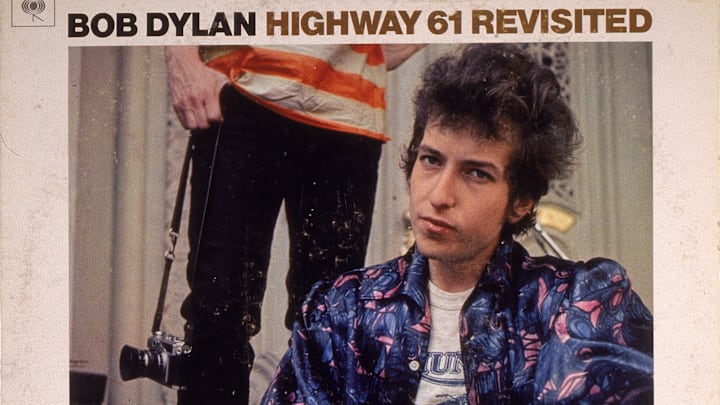Highway 61 Revisited is the sixth studio album by American singer-songwriter Bob Dylan, and also quite a song from that same album.
Released on August 30, 1965, the album is widely regarded as one of Dylan's greatest works and a landmark in the history of rock music. It has quite a reputation" and historical context. For starters, it's one of the early albums featuring a shift to electric guitar, marking a significant transition for Dylan from his earlier folk style to a more rock-oriented sound.
It followed the release of his half-electric, half-acoustic album Bringing It All Back Home and his controversial electric performance at the Newport Folk Festival in July 1965. Somewhat ironically, many in the crowd rejected that performance, despite the man who introduced him on stage saying "And here he is…take him, you know him, he’s yours.")
This album also had a profound impact on the music industry and popular culture, influencing countless artists and helping to shape the sound of rock music in the 1960s, similar to "Beatlemania" a few years earlier. (For the record, I seriously considered listing Dylan as one of the 16 artists who best embody rock and roll.)
Sure, not everyone's a Bob Dylan fan, but he was one of the major lyrical forces in music, encouraging other songwriters to follow their own vision, blaze their own paths. Bono of U2 once said, "Every songwriter after him carries his baggage...," and this album has quite a tracklist for what was absolutely a unique trip at the time.
Most memorable moments from Highway 61 Revisited
The album opens with "Like a Rolling Stone," which is one of Dylan's most famous and critically acclaimed songs, inspiring the names for the band The Rolling Stones and Rolling Stone magazine.
Other notable tracks include "Tombstone Blues,"
"Ballad of a Thin Man,"
"Desolation Row," and the title track "Highway 61 Revisited."
Lyrics, themes, and musical style
Dylan's lyrics on this album are known for their poetic, abstract, and often surreal quality. That beingh said, they can sometimes have detectible meaning. For example, "Just Like Tom Thumb’s Blues" makes a fair amount of literary references.
The songs tackle social issues, personal identity, and human relationships. "Like a Rolling Stone" is particularly famous for its biting commentary on societal expectations and personal freedom. The lyrics are all conveyed through a naturalistic musical style — he and his band seemingly didn't concern themselves much with catering to genres (or "micro genres") and just play the songs as they creatively see fit.
The album features a blend of rock, blues, and folk music, but doesn't neatly conform to some generic "folk rock" formula. What we can say is the album is characterized by its regular use of electric instruments, a driving rhythm section, and innovative editing techniques. Mike Bloomfield's electric guitar work and Al Kooper's organ playing are notable contributions to the album's distinctive sound (incredibly, Kooper had never played organ before improvising the iconic organ riff in "Like a Rolling Stone," so he deserves massive credit for that).
Production, reception, and legacy
The album was produced by Bob Johnston, but also Tom Wilson, who had also worked on Dylan's previous albums. In addition to this fol-rock giant, Tom Wilson had produced albums for artists like the Mothers of Invention, Simon & Garfunkel, the Velvet Underground, Sun Ra, Eddie Harris, Nico, and Eric Burdon and the Animals. Not a bad career, right?
Recording sessions took place at Columbia Recording Studios/CBS 30th Street Studio in New York City (nicknamed "The Church"). Upon its release, Highway 61 Revisited received widespread critical acclaim and was a commercial success, reaching No. 3 on the Billboard 200 chart. It is frequently cited in various "greatest albums of all time" lists and has been inducted into the Grammy Hall of Fame.
It's also an example of why chatter about the "death of the album" depresses some people. Sure, maybe one can argue it's great to have a song as influential as Robert Johnson's "Cross Road Blues." However, what if that one song is made even more impactful by being paired with a batch of other songs compiled together? What a concept!
Highway 61 Revisited remains a seminal work in Bob Dylan's discography and a crucial album in the evolution of rock and folk music.
And hey, if some of its lyrics are too "out there" for you, there is always "Blowin’ in the Wind."
Final thoughts on the absurdist lyrical moments
In particular, Highway 61 Revisited has been praised for its often abstract yet socially charged lyrics. Protest music at the time was often addressing racial inequality and poverty as well as current events such as Vietnam War and civil rights protests. On this album, Dylan more often spoke almost in code, and conveyed a sense of protest through mood.
Like Beck's song "Loser," which came out decades later, Dylan would often use mood and absurd word contortions to convey meaning, or a sense of meaning. Basically, even if you don't quite know what the words mean, you can feel it, and catch little glimmers of meaning from how some words feel. For some, it no doubt makes the album more of an experience. Plus, Dylan would still prove capable of less abstract protest songs with "Hurricane" in 1975.
Still, the more abstract stuff can be great. When references are made indirectly rather than explicitly stated, it makes the listener do more work. Of course, that's partly why musicians like Bob Dylan can be an acquired taste (in addition to the vocal delivery, of course). Still, even the harsh Bob Dylan critics must admit that many indeed acquired the taste, and often found it delectible.
